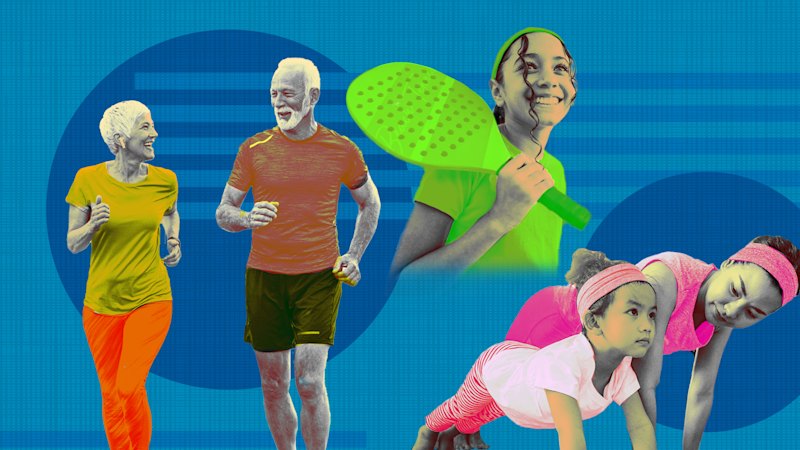
Regular exercise is vital for long-term health, but how should workout routines evolve as we age? With insights from leading exercise physiologists, this article offers a comprehensive guide tailored to fitness enthusiasts at various life stages. The focus is on maintaining health and fitness, rather than training for specific sports or events.
Childhood (Ages 3-10)
The primary objective during childhood is to encourage active play and exposure to diverse physical activities. Children should master basic movements like walking, running, and jumping, while engaging in fun games that promote coordination and social interaction.
Tony Blazevich, a professor of biomechanics at Edith Cowan University, emphasizes that structured adult-like training is not beneficial for children. They thrive on spontaneous play and intermittent bursts of intensity, which naturally enhance their fitness.
“Don’t just get them to run lots and lots of cross-country mileage at the age of 10. That’s not going to work very well,” says Blazevich. By the end of primary school, children should have developed nearly adult-level skills in locomotor and object-control activities.
Grant Tomkinson, a professor at the University of South Australia, highlights the importance of building a solid foundation for lifelong fitness. Engaging in a variety of activities as children helps them retain essential skills well into adulthood.
Adolescence (Ages 10-19)
During adolescence, the focus shifts to solidifying foundational skills and introducing structured gym sessions. As teenagers refine their coordination and strength, appropriate weight training can enhance muscle and aerobic fitness.
Blazevich notes that while adolescents can manage longer, structured workouts, it is crucial to prioritize proper techniques and gradual increases in weights to prevent injuries. Resistance training can offer significant benefits, especially for overweight or obese youths, by boosting confidence and encouraging a lifelong exercise habit.
Tomkinson’s research indicates that even without noticeable changes in body composition, strength and self-esteem can improve dramatically through resistance training programs. “They developed the skills on how to squat and how to bench press and do pull-ups, and they got stronger,” he states.
Early Adulthood (Ages 19-35)
Your 20s and 30s are critical for setting the stage for peak aerobic fitness and strength. This period is when sprinting speed and strength typically reach their highest levels.
Engaging in a balanced approach that includes both strength training and cardiovascular exercises is essential. Blazevich suggests that individuals should focus on activities they enjoy while incorporating strength training sessions weekly to maintain muscle mass and bone density.
“Adherence is always going to be the number one barrier to exercise across the lifespan, so enjoyment has to be a big part of it,” adds Kim Way, an exercise physiology lecturer at Deakin University.
Midlife (Ages 35-60)
As responsibilities mount during midlife, finding time for exercise becomes a challenge. However, maintaining fitness is crucial to manage stress and avoid burnout. Blazevich advises against the all-or-nothing mindset, emphasizing that even short bouts of activity can yield health benefits.
Professionals may gravitate towards high-intensity interval training (HIIT) for its efficiency. Way points out that while HIIT can significantly improve fitness, it is vital to limit these sessions to two or three times a week to prevent injury and fatigue.
With menopause, women particularly benefit from strength training to counteract muscle and bone mass loss. Tomkinson notes that power training should also gain emphasis since it declines more rapidly with age than strength or endurance.
Later Adulthood (Ages 60 and Above)
In later adulthood, the goal shifts to slowing the age-related decline in strength and fitness. Regular physical activity becomes increasingly important to prevent falls and maintain functional independence.
After age 65, muscle size can decline by approximately 3 percent annually. To combat this, resistance training is crucial. According to Andy Philp, who leads the Centre for Healthy Ageing at the Centenary Institute, even light workouts can yield significant benefits.
A study in Canada revealed that lifting lighter weights with higher repetitions produces similar advantages to lifting heavier weights, provided individuals work to failure.
Balance and mobility training are equally essential, as falls pose a serious risk for older adults. Tomkinson stresses that improving muscle power can enhance the ability to recover from trips, significantly reducing fall risk.
In conclusion, understanding how exercise needs change with age is vital for maintaining health and fitness. By following the expert recommendations tailored to each life stage, individuals can enjoy a more active and fulfilling life.






